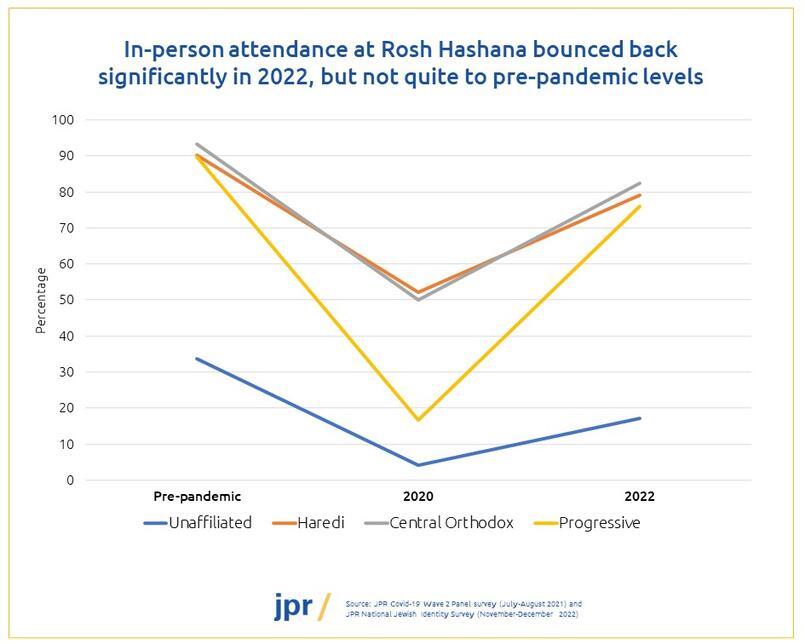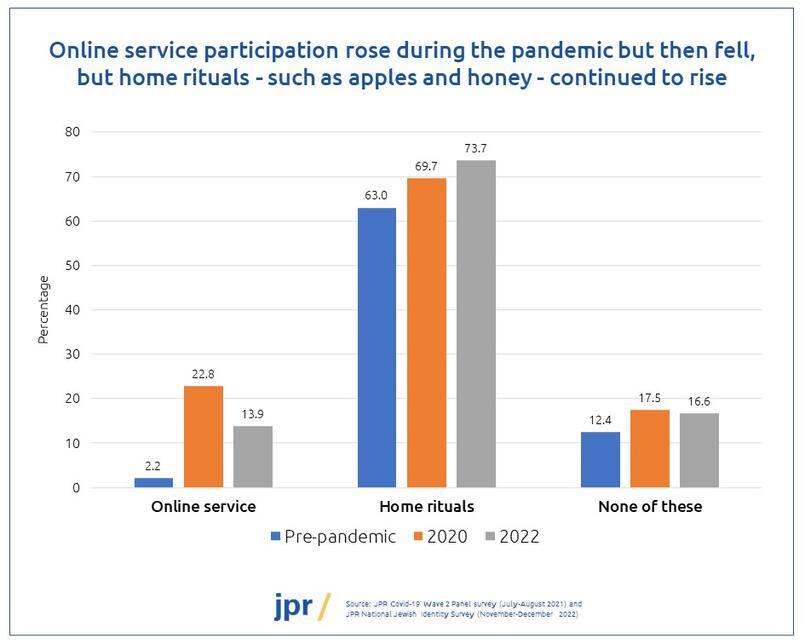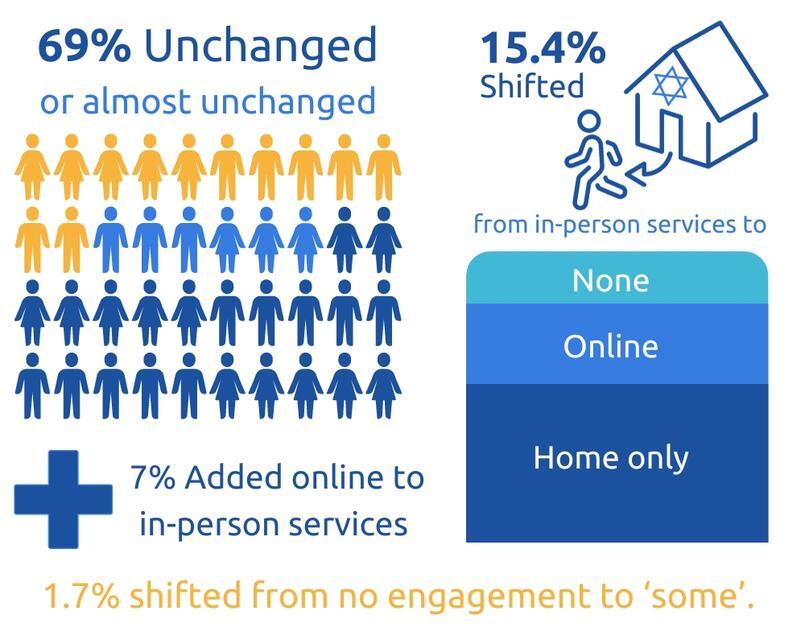The latest data on engagement with Rosh Hashana, before, during and after the pandemic, reveals that even though synagogue attendance rates have not bounced back fully, there are encouraging signs
Dr Carli Lessof
Dr Carli Lessof
Rosh Hashana, the Jewish new year, is one of the most important days in the Jewish calendar. Attending synagogue on this day and on Yom Kippur, which follows soon after, is an aspect of community practice recognised by Jews of every affiliation and none, whether they attend services daily, weekly, at this time of year only, or not at all.
When Covid-19 disrupted in-person gatherings for many months, community leaders and commentators inevitably speculated about post-Covid recovery. Would congregants ’lose the shul habit‘? Were online services here to stay, providing for those marginalised from communal worship or providing a convenient escape for those who preferred to log on or choose services far away from home? Might Jewish practice desert the synagogue and flourish at home, with the shofar sounded from street corners instead?
As we approach Rosh Hashana 2023, it’s timely to look at the latest evidence from JPR’s Research Panel, assess whether the Jewish community in the UK returned to its normal patterns last year, or at least describe what the ’new normal‘ looked like. 2,882 of our panel members who took part in two surveys – JPR’s ‘Wave 2’ panel survey (in July-August 2021) and our 2022 National Jewish Identity Survey (in November-December 2022), told us how they welcomed the new Jewish year before, during and after the pandemic. Our initial results – illustrated here with three revealing graphics – provide a mix of positive, negative and curious signs.
Before the pandemic, over 7 in 10 Jews (71.5%) ‘normally’ attended synagogue on Rosh Hashana. But when Rosh Hashana fell between the first lockdown (from March to June 2020) and the second lockdown (in November 2020), communal religious worship was only allowed under very restricted circumstances, with social distancing measures and constraints on the length of services, and many communities limiting the number of attendees. Some offered multiple smaller services, some supported garden prayers, at least one offered a 'drive-in', while others almost certainly met in numbers which exceeded the regulations. Still, just less than three in ten Jews in the UK (28.1%) attended synagogue in person in Rosh Hashana 2020.
Before the pandemic, over seven in 10 Jews (71.5%) ‘normally’ attended synagogue on Rosh Hashana… last year, in-person synagogue attendance had recovered to almost 6 in 10 Jews (58.1%)
At that time, concerns about rising infection rates and a possible future lockdown were still current, and the vaccination programme had not yet begun. It is not surprising, then, that the numbers had fallen substantially. In contrast, by Rosh Hashana 2022, restrictions had fully lifted, vaccinations were widespread, and in-person synagogue attendance had risen to almost 6 in 10 Jews (58.1%). That said, recovery was incomplete, with attendance 13.4 percentage points lower than ‘normal’ practice reported before the pandemic began.
The first graph below shows that this pattern – a significant dip and a substantial but incomplete recovery – can be found in every part of the community. Engagement before and after the pandemic looks remarkably, and perhaps surprisingly, similar across denominations. However, while the dip looked nearly the same for central and strictly orthodox (Haredi) members of the community, dropping to just above 50% reporting in-person attendance, progressive Jews (Reform, Liberal and Masorti) were much more likely to avoid synagogue at that time: under 20% of them did so in 2020, before bouncing back last year. Although further analysis might narrow down the possible explanations, we can speculate that this resulted from a combination of factors, including a lower supply of synagogue places and wider acceptance of online alternatives when provided. Finally, unaffiliated Jews were much less likely to attend synagogue but showed the same return pattern, though again, not to the same level as before the pandemic.

During the pandemic, many Jews discussed the possibility that online services would alter the community landscape fundamentally, positing that there might be an increasing focus on in-home activity, and that some would simply let go of the religious or cultural engagement they held before the pandemic. Although further analysis is needed, all of these ideas are to some extent substantiated by evidence from Rosh Hashana last year, as shown in the graph below.

Indeed, the pandemic was a period of innovation, with increased online and telephone services offered instead of – or as well as – in-person gatherings. During the pandemic, 22.8% of the Jewish population attended online Rosh Hashana services, a ten-fold increase from before the pandemic. While this dropped substantially in 2022 to 13.8%, it remained five-fold higher than pre-pandemic levels. Carrying out home rituals, such as eating apples and honey, rose from 63.0% before the pandemic to 69.7% during it. Unlike online activity, performing home rituals continued to increase even after restrictions had been lifted, to 73.7% last year. The findings also seem to confirm fears that some habits broken might not recover; the percentage of people who did not observe Rosh Hashana in any way grew from 12.4% before the pandemic to 17.5% during Covid, settling back slightly to 16.6% in 2022.
It is worth mentioning that these activities aren’t exclusive: one can go to synagogue, attend an online lesson and perform rituals at home; in fact, many Jews do. The infographic, below summarises the change (or lack of change) in patterns of behaviour shown by individuals, simply comparing two points in time, before and after the pandemic. Most noticeably, it shows that a majority of Jewish people (69%) returned to the same behaviours they reported before the pandemic – this includes those who did not observe Rosh Hashana at all, either before or after the pandemic, as well as those who did.

The movement to and from synagogue services flowed both ways. While just under 7% of Jewish people who attended in-person synagogue services added some online element, 15.4% shifted away from in-person services. This is comprised of three groups, those switching to online services (4.4%), those only observing home rituals (8.4%) and some who did none of these (2.7%). Although proportions are small, it’s also worth noting that 3.1% who said they normally only participated in home rituals incorporated in-person and/or online services (not shown), and a further 1.7% reported some engagement in 2022 when they said they did not normally participate in Rosh Hashana in any of these ways before the pandemic.
So, will the synagogue be full in the coming days as we welcome in the new Jewish year? Drawing on existing data, we can’t be certain whether in-person services will return to their pre-pandemic levels or remain slightly depressed. But even if community members do return to their pre-pandemic proportions, the Jewish community may nevertheless have changed in important ways. It will be interesting to see if this possible trend towards increased ritual behaviour in the home continues and to examine the resilience of online services. And we should keep a closer eye than ever on those who don’t engage at all, particularly if they did before the pandemic. The effects of the last few years continue to be felt in many people’s lives, and the holiday period is almost certainly one of the critical times when we will see that.
Associate Fellow; Honorary Research Fellow, UCL
Associate Fellow; Honorary Research Fellow, UCL
Carli completed her PhD in Social Statistics at the National Centre for Social Research at the University of Southampton and holds an MA in Applied...
Read more